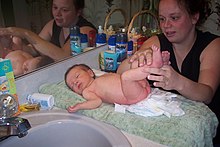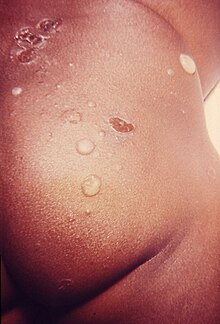Diaper rash
| Classification according to ICD-10 | |
|---|---|
| L22 | Diaper rash |
| ICD-10 online (WHO version 2019) | |
A diaper rash , also known as diaper rash , the term, because the causes can not be varied for a particular disease. The term only indicates the location of acute , less often chronic, irritation ( inflammation ) of the skin . The Latin terms, on the other hand, refer either to the region ( erythema glutaeale ) or to the causes ( dermatitis ammoniacalis , dermatitis pseudosyphilitica papulosa , erythema papulosum posterosivum , posterosives syphiloid ).
Diaper dermatitis manifests itself as soreness in the diaper region .
An initially simple skin irritation can result in minor injuries due to the softening of the skin. These favor the colonization with fungi , but also bacteria . This quickly turns a banal reddening ( erythema ) into an infection . If fungi have settled, one no longer speaks of diaper rash, but of diaper thrush .
Epidemiology
Diaper rash is a widespread disease of civilization . About two thirds of all swaddled children are affected who suffer at least once, but often more often, at least a mild form of diaper rash in infancy or toddler age .
In the UK, it accounts for twenty percent of childhood visits to the doctor for skin diseases, with twenty-five percent of newborns occurring in the first four weeks of life . Infants between the ages of nine and twelve months are most commonly affected. In the United States, diaper rash is the cause of one million doctor visits a year, with no differences in ethnicity .
In contrast to disorders in the digestive tract , fully breastfed infants develop diaper rash only slightly less often than children who are weaned early.
The disease is not limited to children, however. People of any age who wear protective trousers because of stool or urinary incontinence can develop diaper rash.
causes
The causes of diaper rash can be varied:
- The main cause is a build-up of heat, which is caused by the rubber pad and the plastic pants of a modern diaper . Due to the actually desired air and water impermeable covering of skin areas ( occlusion ) and the frequent emptying of the bladder ( micturition ) in infants , the formation of a so-called “humid chamber” with swelling ( maceration ) of the horny layer of the skin (stratum corneum) occurs and from this the following impaired skin barrier function.
- The urea (urea) present in the urine is broken down into ammonia by alkaline decomposition ( urease ) , which increases the pH value , comparable to constant hand washing with soap .
- In addition, constant contact with urine and stool , particularly in the case of diarrhea , increases the activation of digestive enzymes ( peptide bond hydrolases and lipases ). Thus it has an additional leaching and damaging effect on the skin. After the protective acid mantle has been destroyed, the skin is susceptible to various pathogens such as fungi (especially yeasts of the Candida group such as Candida albicans ) and bacteria ( impetigo contagiosa , especially staphylococci such as Staphylococcus aureus and streptococci ).
- A generally poor health of the child, but especially the inherited , genetic condition ( predisposition ) to develop an atopic eczema , a seborrheic dermatitis or psoriasis (psoriasis) favor this secondary settlement .
- The colonization can be both a consequence and a cause of diaper rash.
- In addition to the local conditions in the diaper area, the cause often lies in the infant's intestine when it is colonized with fungi ( intestinal candidiasis ).
- The intensive contact of the skin with care products that contain fragrances or preservatives ( cleaning wipes , ointments , creams , but also soap) promotes intolerance . If you suspect an intolerance to the care products used, they should be applied to a different part of the body and tested, or they should be avoided altogether.
- Diaper intolerance can also occur; as a rule, these are now ready-made diapers.
- Detergents or fabric softeners contain numerous fragrances that the child can react to.
Symptoms (recognition features)
- The diaper rash occurs in the diaper area, i.e. in the genital and anal area . Affected are those skin areas that are covered by the diaper, i.e. the buttocks , external genital organs , groin region and thighs . However, it can spread to the back and lower abdomen . The deep folds of the skin are less affected because there is no direct contact between the skin and the diaper.
- There is a blurred reddening with possibly oozing blisters ( vesicles ) or blisters , swellings ( edema ), secondary skin or mucous membrane changes ( erosions ) and scaling ( desquamation ) or scabs ( exudate ).
- Touching the affected region (for example when changing diapers), but also rubbing the diaper, can be very painful for the child, making him uncomfortable and screaming more.
Complications (possible consequences)
- Secondary infection
- with yeasts of the Candida group (Candida mycosis), especially Candida albicans. This can also spread to the intestines (intestinal candidiasis).
- with bacteria (impetigo contagiosa, mostly staphylococci such as Staphylococcus aureus and streptococci); the skin folds are also affected.
- Granuloma glutaeale infantum : granulomatous disease of unknown cause, possibly reaction to Candida antigens
- Whitish-yellowish blisters or nodules ( papules ) as a result of the fungal infection can also occur in the immediate vicinity .
- Scaly rash (seborrheic dermatitis).
- Another possible but rare complication is that the symptoms spread to other parts of the body: In some cases, small-spotted, scaly reddening suddenly appears on the trunk, arms and legs, face and hairy head. In extreme cases, the entire skin can be affected over a large area.
- When treating a fungal infection with cortisone, there is a risk of tissue atrophy of the skin. Since infants have a much larger body surface area compared to their body weight than adults, the hormone can be better absorbed by the baby's skin and blood vessels and there is the possibility of systemic side effects as the skin becomes thinner and therefore more porous and more vulnerable.
treatment
Diagnosis (examination)
- Careful assessment of the complaints.
- If the diaper rash is suspected of being infected with yeast or bacteria, the doctor may take a swab for microbiological tests.
- Differentiation of the disease from diseases with a similar appearance such as eczema of different causes, psoriasis or herpes simplex .
Prevention (prevention)
- Change the diapers regularly as required, at the latest after three to four hours.
- Avoid heat build-up by putting the diaper on as loosely as possible and under no circumstances too tight.
- Wash as little as possible so that the skin does not swell.
- Avoid intensive skin contact with care products that contain fragrances or preservatives (cleaning wipes, ointments, creams, but also soap), as these can trigger allergies and destroy the natural skin barrier.
- Remove dirt and ointment residues with a gentle oil (for example almond or olive oil ).
- Careful cleaning and drying of the genital and anal area as well as the inner thighs, especially in the skin folds.
- Refrain from wearing diapers as often and for as long as possible (when changing diapers, make sure that the child lies on the changing table without a diaper and can kick it for as long as possible ).
- Avoid acidic and spicy foods in children and nursing mothers.
Therapy (treatment)
The preventive measures also apply to therapy, but there are other treatment options:
- Do not use any aids such as cleaning cloths, ointments, creams or soap. Use warm water and soft, clean towels to clean when changing diapers. The rough cleaning is done with soft disposable cloths without any care products, then a thorough cleaning, ideally with clean cotton cloths, which are then to be cleaned in the boil wash.
- If absolutely necessary, only apply moisture-absorbing pastes ( e.g. soft zinc oxide pastes) in a thin layer. The zinc oxide paste is best used in combination with paraffin oil or cod liver oil ; this makes it easier to spread, making it easier to apply and protecting the child.
- If you suspect an intolerance to a certain diaper, try changing the diaper brand for several days or using cloth diapers .
- If you have a fungal infection, i.e. diaper thrush, you should definitely consult a doctor.
- A diaper thrush is treated with a special fungus-inhibiting paste ( antimycotic ), possibly combined with a weakly effective ointment- based hydrocortisone in the case of severe courses .
- If a fungal colonization of the intestine is suspected (intestinal candidosis), the stool should be examined for fungal colonization. If there is bowel candidiasis, the mouth and bowel must be treated .
- Bacterial infections can be treated with antibiotics .
- In the event of fungal or bacterial colonization, textiles that have come into contact with the affected skin areas (e.g. clothes and towels) should only be used once and washed as hot wash before the next use in order to kill the pathogens and prevent re-infection.
See also
literature
- The new handbook of health for the whole family. Mosaic, Munich 1984.
- P. Fritsch: Dermatology and Venereology. 2nd revised edition. Springer, 2004, ISBN 3-540-00332-0 .
- Helmut Hildebrand (Hrsg.): Pschyrembel - Clinical Dictionary. 259th revised edition. de Gruyter, 2002, ISBN 3-11-017621-1 .
- Malteser: Practical Guide Medicine and Health - Knowledge, Advice, Self-Help. Dorling Kindersley, Munich 2000, ISBN 3-8310-0049-2 .
- Gernot Rassner: Dermatology: Textbook and Atlas. Elsevier, Urban & Fischer, Munich / Jena 2007, ISBN 978-3-437-42762-6 .
- Peter Reuter: Springer Lexicon Medicine. Springer, Berlin a. a. 2004, ISBN 3-540-20412-1 .
Web links
- Patient information sheet: what is diaper rash? - Clinic for Dermatology and Allergology at the Ruhr University Bochum
- Candidiasis of the skin - guideline of the German dermatological society
- Pictures on paediatrie-in-bildern.de
- Skin problems - kindergesundheit-info.de: independent information service of the Federal Center for Health Education (BZgA)
Individual evidence
- ↑ P. Fritsch: Dermatology and Venereology. 2nd revised edition. Springer, 2004, ISBN 3-540-00332-0 .
- ^ R. Philipp, A. Hughes, J. Golding: Getting to the bottom of nappy rash. ALSPAC Survey Team. Avon Longitudinal Study of Pregnancy and Childhood. In: Br J Gen Pract. 1997 Aug; 47 (421), pp. 493-497. PMID 9302788 .
- ↑ Daniel B. Ward, Alan B. Fleischer Jr, Steven R. Feldman, Daniel P. Krowchuk: Characterization of Diaper Dermatitis in the United States . In: Arch Pediatr Adolesc Med. 2000; 154, pp. 943-946. PMID 10980800
- ↑ PW Howie, JS Forsyth, SA Ogston, A. Clark, CD Florey: Protective effect of breast feeding against infection. In: BMJ. 1990 Jan 6; 300 (6716), pp. 11-16. PMID 2105113
- ↑ Kinderzeugs.de , prevention and treatment of diaper rash.

